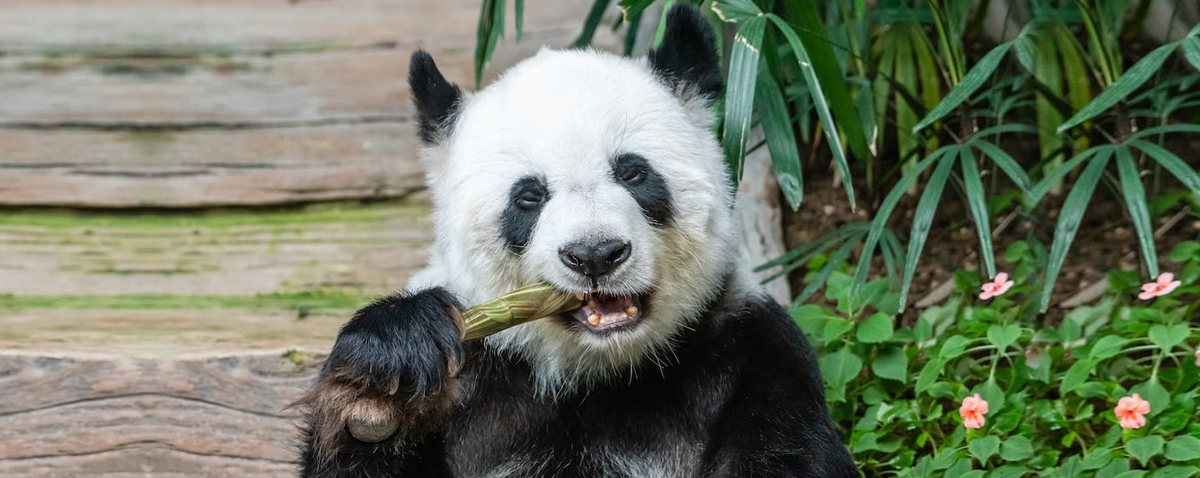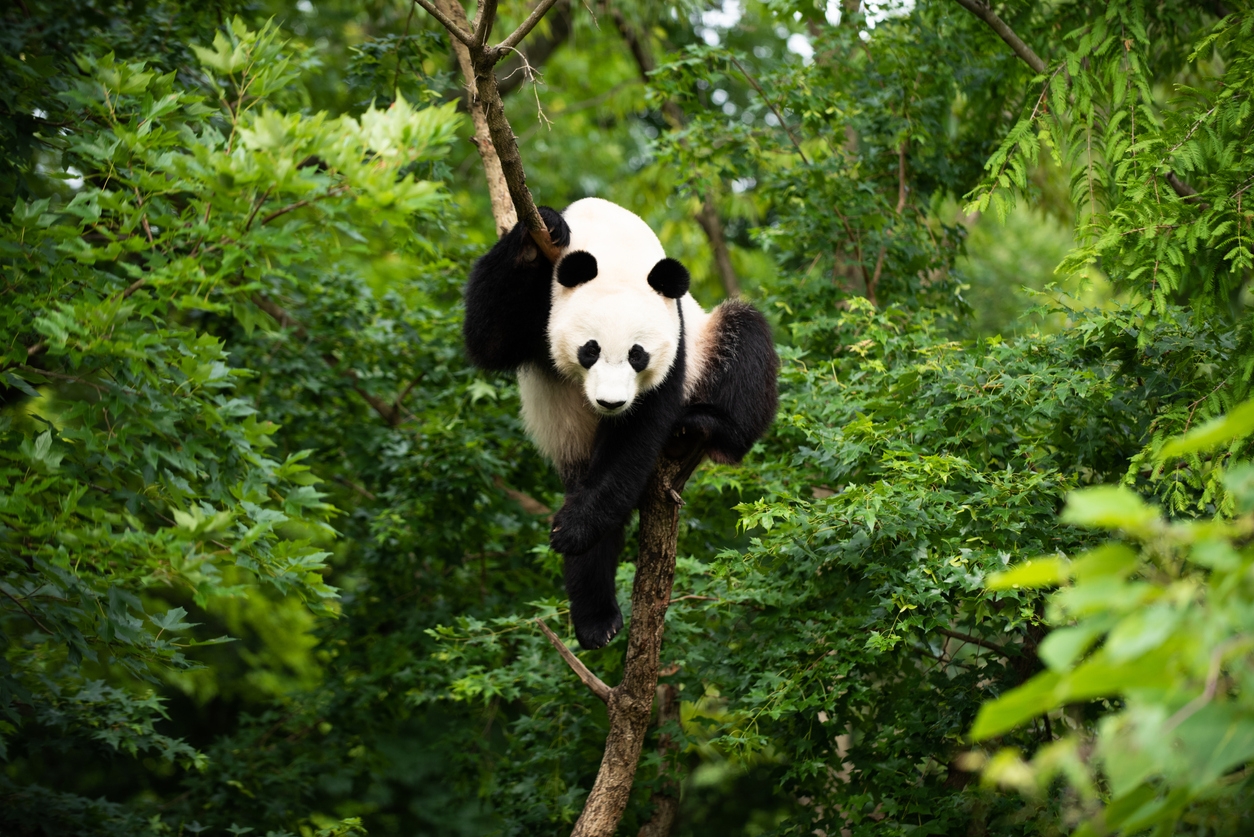Pandas are fascinating. Yet, there’s a side to them many don’t know. After birth, their odds of survival depend on a range of factors. As adults, reproduction presents its own set of challenges. For instance, female pandas have a mere few days a year when they can conceive–a fleeting window amidst myriad hurdles. This article discusses the survival rate of baby pandas and the difficulties of pandas having babies.
General information about Pandas
Pandas are bears native to China. They belong to the family Ursidae and are known for their distinctive black-and-white fur. [1] These adorable beings are herbivores, relying on bamboo for their daily nutrition. However, some people classify pandas as carnivores, even though they primarily eat bamboo in their daily routine.
Pandas originally received the title of “endangered species,” However, various threats to their wellbeing saw their status change from endangered to vulnerable on the IUCN Red List. [2] As such, various conservation efforts were made to safeguard these unique bears.
Endangered and Vulnerable
Pandas are at risk of extinction in the wild. Habitat loss and fragmentation from activities like deforestation and infrastructure development are the key threats facing these animals. Pandas face increased difficulty in finding adequate food and suitable areas for breeding, resulting in poor birth and survival rates.
The good news is that relevant organizations have been working tirelessly to safeguard and converse panda populations. Anti-poaching patrols, habit restoration and other similar efforts have helped stabilize the panda survival rate. [3] While there’s still a long way to go, the future looks healthier for these unique animals.
Challenges of Panda Reproduction
Pandas are undeniably adorable. But their reproduction cycle is quite complicated and is affected by several factors. [5] Below are some difficulties they face during the process.
In the Wild
Pandas face numerous obstacles in breeding while in the wild. Deforestation and human encroachment have greatly reduced their natural habitat. This has resulted in fragmented populations, making it difficult for pandas to find suitable mates for reproduction purposes. Pandas also have a low reproductive rate in general. Female pandas are fertile only for a few short days each year. They only give one to two cubs at a time in 2-3 years. The elusive nature of pandas and short window of fertility makes it harder for male pandas to locate and breed with females. Not to mention, the competition can be quite fierce in the panda world, with stronger males often taking up most mating opportunities. This severely limits the growth rate of the panda population in the wild.
In Captivity?
Breeding pandas in captivity poses challenges. Captive breeding programs are critical for panda conservation, but reproduction in captivity is not without difficulties. Natural cues for mating are lacking in captivity, unlike in the wild where pandas rely on scent, vocalizations, and visual cues during the short breeding season. Health issues like obesity, dental problems, and hormonal imbalances can impact reproductive health of captive pandas, reducing successful mating and pregnancy.
Despite all that, captivating breeding programs have been successful in producing panda cubs and releasing them into the wild. [6] Their efforts like hormonal management and artificial insemination techniques have brought a positive change in the panda territory. Additionally, conservation efforts are constantly being made to grow the population of these iconic bears.
How Many Pandas are in the Wild? In Captivity?
Wild pandas are found in China’s mountain ranges, with an estimated population of around 1,800. China has established breeding and research centers, resulting in over 600 pandas in captivity. [4] Captive breeding has successfully reintroduced pandas into the wild as part of conservation programs.
The table below presents estimated population numbers:
| Population | Estimated numbers |
| Wildlife | 1800 |
| Captivity | 600+ |
There are special breeding and research centers for managing the captive population of pandas. These centers have successfully managed to increase the overall panda population. Some of their work involves creating the ideal habitat and nutrition program for pandas in that environment.
Odds of Panda Cub Survival After Birth
Pandas capture people’s hearts with their innocence and charm. Yet, behind those playful eyes lies a silent struggle, especially for the tiny cubs.
When a panda cub is born, it’s not much bigger than a chocolate bar. It’s blind, delicate, and relies entirely on its mother. Just picture a new mom, holding her baby close for warmth and protection. This is a panda mother’s full-time job. Her baby’s soft whimpers guide her, as she shields it from the world.
Despite her endless care, the odds can be daunting. In nature, the survival game is tough. But even in closed facilities, baby pandas may find it hard to survive. For instance, panda cubs’ survival rate in Chinese breeding centers (most captive breeding takes place here) is between 35% and 48%). [5]
In zoos, the challenges persist. Even with round-the-clock care, some cubs face health hiccups. Maybe they struggle to feed or fight off a minor infection. But zookeepers press on, using every tool and trick to ensure each cub thrives.
For each panda cub, life starts as a battle. But with a mix of nature’s resilience and human dedication, many overcome the odds, growing into the playful pandas we adore so deeply.
All of these factors combine to influence the odds of a panda being born and surviving. By summarizing the survival rates of panda cubs in different regions, a table is created to simplify this information for better understanding:
| Region | Survival Rate |
| Wild | ~60% |
| US | 75% |
| China | 35-45% |
Fascinating Facts about Pandas
- Pandas have poor eyesight and rely heavily on their sense of smell to locate food and navigate their environment.
- Giant pandas are excellent climbers and can climb trees as well as steep mountain slopes.
- Pandas have a special adaptation on their paw pads that helps them grip slippery surfaces, such as the bark of trees or wet bamboo stalks.
- Baby pandas are incredibly small, weighing only around 3 to 5 ounces at birth.
- While pandas may seem slow and docile, they can actually run at speeds of up to 20 miles per hour when necessary.
- The black patches around a panda’s eyes and ears help to reduce glare and enhance their vision, while their white belly helps them blend in with the snow.
- Female pandas have a very narrow window of time, typically only a few days each year.
- Pandas have a unique digestive system that is not very efficient at extracting nutrients from bamboo, so they have to eat a lot of it.
- Giant pandas like to lick copper and iron, and can lift metal bowls with their paws.
- Pandas are naturally curious, lovely, and playful, particularly when young.
Conclusion
As you can see, the odds of a panda surviving after birth and successful panda reproduction are affected by various factors. Pandas have a good chance of surviving provided they get a suitable habitat and are taken care for by conservatives. However, efforts need to be made to increase the overall panda population worldwide. To summarize, the important points we discussed are:
- Pandas in Chinese breeding centers have a 35% to 48% chance of surviving after birth.
- In the United States, baby pandas have a survival rate of 75% during their first year of life
- Special efforts are being made to improve the health and diversity of pandas.
- Pandas face challenges in captivity, such as limited gene pools and health issues, which can reduce their fertility
- Region difference affects the chances of baby panda survival.
Remember that efforts are being made to increase the odds of panda survival after birth. It’s likely that new technology and techniques will positively impact this bear tribe in the future.
References
- Darin M. Collins. (2015). Ursidae. https://www.sciencedirect.com/. https://www.sciencedirect.com/topics/agricultural-and-biological-sciences/ursidae
- Panda no longer ‘Endangered’ in IUCN red list update. (2020, September 30). Earth Journalism Network. https://earthjournalism.net/stories/panda-no-longer-endangered-in-iucn-red-list-update
- Lessons from panda conservation could help Asia’s other, overlooked, bears. (2023, February 4). Mongabay Environmental News. https://news.mongabay.com/2022/05/lessons-from-panda-conservation-could-help-asias-other-overlooked-bears/
- Giant pandas. (n.d.). Association of Zoos & Aquariums | AZA.org. https://www.aza.org/connect-stories/stories/giant-pandas-a-collaborative-success-story-national-zoo-50-years
- TODAY, U. (2012, September 25). Dead cub shows how hard panda breeding can be. USATODAY. https://www.usatoday.com/story/news/2012/09/25/panda-breeding-dead-cub/1590545/
- Captive breeding program. (n.d.). https://www.pandasinternational.org/program-areas-2/captive-breeding-program/



